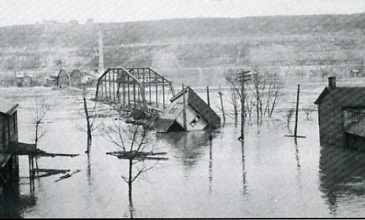
Sharon Bridge with middle span gone in flood, March, 1913.
Click Here to Return to Milestones

I've been familiar with bridges since an
early age, because to get anywhere in the Western Pennsylvania
area you must cross countless bridges.
Just the same, I've never been keen on bridges. Looking back,
I think I know why.
I was not quite six years old and my brother Jerry was an infant
in the summer of 1940. With Jerry in a baby buggy and me in tow,
our mother got her good-weather exercise by visiting friends and
family on foot.
One sunny Saturday afternoon, Mom, Jerry and I were visiting Mrs.
Virginia Gray in New Brighton, PA.
Mom and Gray decided to pack lunches and visit their husbands,
employees of the Pennsylvania Highway Department stationed at
the Bridgewater, PA. garage.
The women decided to walk the two miles to the garage. To get
there, we had to cross the Beaver River.
Mom and Mrs. Gray thought little of the trip, since at the time
a bridge traversed the river.
They loaded up their baby buggies (Mrs. Gray also had an infant)
and we headed out
Upon arriving at the bridge, the women learned something they
had not known previously.
The Sharon Truss Bridge, which connected the village of Sharon
(later changed to Upper Bridgewater) and New Brighton was in the
process of being dismantled.
The 653-foot bridge had been designed and built in 1889 to carry
the Beaver Valley Traction Co.'s railroad tracks across the river
approximately two miles south of New Brighton.
The women decided to cross, despite the fact that members of the
dismantling crew had left the site for the weekend, apparently
believing that there was little need to blockade the bridge's
approaches.
However, by the time we reached the middle of the bridge, the
situation did not look good.
Dismantling had begun near the center of the bridge, and much
of the bridge's roadbed was gone.
Stretching out in front of us was a crisscrossing pattern of loose-fitting
beams - and little else.
Records at Carnegie Library in Beaver Falls tell of extensive
damage to the bridge caused by a flood in 1913. Fire also damaged
the facility in 1932. Finally, the St. Patrick's Day flood of
1936 greatly reduced the stability of the bridge, limiting it
to vehicle and later pedestrian use. The 1913 flood had washed
away the middle of three 197-foot spans; and while the bridge
had been repaired to again permit train traffic, the facility
continued to fall into disrepair. The railroad discontinued use
of the bridge in 1926 when tracks were relocated to the east side
of the river so as to connect the towns of Beaver Falls and Rochester.
The bridge remained in use for vehicular traffic until the 1936
flood.
Finally, because of its declining condition, only pedestrians
used the bridge. In the final years of the bridge's existence,
law enforcement officials attempted to discourage pedestrian use
because of the bridge's ever-worsening condition.
From the New Brighton side of the bridge, the pedestrian walkway
had appeared to Mom and Mrs. Gray to be completely intact. But
halfway across the bridge, we found that boards were missing in
the walkway. Worse, the walkway was so narrow that the baby buggies
couldn't be turned around.
The women looked at each other, tears welling in their eyes. It
must have been a terrible feeling for them, standing there in
the middle of a partially dismantled bridge and the river beneath
rushing by.
With no other option, Mom and Mrs. Gray continued on their way.
At one point or another, each of us stumbled and slipped partially
through the walkway but managed to right ourselves and go on.
Most importantly, we kept the baby buggies upright.
Some time later, we arrived at the highway garage. Mom and Mrs.
Gray delivered their husbands' lunches, and everything seemed
to be fine until my Dad realized no car was present. He asked
how we got there. The look on the men's faces was one of shock
and then dismay as first Mom and then Mrs. Gray related their
stories. Finally, realizing that everyone had arrived safely,
the husbands embraced their wives and hugged their children. I
experienced many emotions that day, not the least of which was
the thrill of riding home in the towering front seat of a highway
truck. But the feeling that has stayed with me throughout my life
is a constant and very unsettling reluctance about bridges.